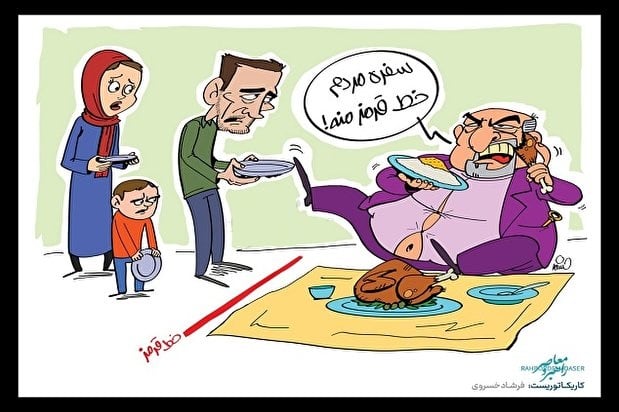Workers in Iran are part of the labor force who are engaged in various sectors of production or services as defined by law, and their population is more than 10 million people, about 12 percent of the total population. The question here is, how is the situation of the workers in Iran after 42 years of clerical rule?
And the question is very clear. In the past 42 years, despite the huge oil revenue of the country, not only has the living and working situation of the workers not changed but is becoming worse and the vast majority are living under the poverty line.
The oil revenue of the government in the years when it was not under international sanctions earned it an average of $100 billion a year from oil exports.
This huge amount of income could have been used to change the lives of the workers and the development, public welfare, education and upgrading of Iran’s infrastructure, but it was not, and the money was pulverized for trivial subjects.
The rent-seeking and mafia system in Iran, to pay the costs of its people’s repression and its global terrorism, has been shrinking the people’s incomes.
Printing fiat money and adding to liquidity has had a direct impact, especially on workers’ lives. We hear this effect daily in the protest slogans of this group and other low-income groups: “Our incomes are based on rial, but the costs are based on dollar.”
In this expression, a simple reality is hidden. According to the state-run media, the amount of the country’s liquidity in 2014 was around 782 trillion tomans. (State-run daily Shargh, May 23, 2020)
And suddenly at the end of this month (May 2020) it reached an amount of 2651 trillion tomans. (From the report of the Central Bank, June 23, 2020)
This huge increase hurts in the first place the low-income strata, especially the workers. In a clearer sense, workers’ wages if paid on time and not delayed for months have often remained stable or changed slightly.
On March 13, 2021, the Supreme Labor Council announced that in this year, 39 percent would be added to workers’ salaries, “and that the minimum wage for workers next year will be 2.656 million tomans, which with other wage items will reach over 4 million tomans.” But this did not happen. (State-run website Rahborde Moaser, March 13, 2021)

The announcement of the minimum wage for workers is while according to the statistics of the Central Bank in November and December 2020, the cost-of-living basket for a working family of 3.3 people was 9 million Tomans. The state-run news agency IMNA about the poverty line wrote: “Many studies have shown that the poverty line in Tehran has reached 10 million tomans.”
Even more disappointingly, it added: “It is definitely not possible to announce the poverty line in our country because the issue of livelihood or poverty line is related to the basic goods that are in the cost basket and we are always faced with exchange rate fluctuations with goods that a family needs to make a living.”
The most conservative estimates show that workers’ wages are close to a quarter of the poverty line. As mentioned, this is best situation predicted for a worker who have a stable job and be paid on time.
Now just a few statistics will show us the catastrophic situation of the workers and their families.
According to official statistics, “The working population in the country is 5.7 million households. About 12 million children, or about half of the country’s children, live in these families.” (State-run daily Shahrvand, May 2, 2020)
“There are 14,000 garbage collectors in Tehran, of which 4,600 are children. There are half a million working children in Iran who, if they do not work and do not take to the streets, the natural course of their lives will fall in deep crisis.” (Mostaghel, May 10, 2020)
“Official statistics show that there are 3.6 million women heads of households” in Iran. (Javan, April 27, 2020)
On August 30, 2017, the Ministry of Roads and Urban Development announced the number of slum dwellers in Iran as 19 million and the number of slum dwellers in Tehran as 4.2 million. On July 21, 2017, the Ministry of Roads and Urban Development announced the number of slum dwellers in Iran as 19 million and the number of slum dwellers in Tehran as 4.2 million.
Now the number of the slum dwellers has, “increased to 32 million of Iran’s 85 million population. In Tehran, the marginalized population has increased to 11 million.” (Arman, April 12, 2020)
The other side of the coin of these catastrophic situations are wealth accumulation and rent-seeking of the officials. “It is said that 500 people have a major part of this amount of liquidity [2651 trillion Tomans].” (Mostaghel, June 1, 2020)
“The wealth of all the economic institutions of the ‘House of the Velayat-e-Faghih’ (Iran’s supreme leader Ali Khamenei) is equivalent to one trillion dollars. The ten percent profit of this wealth is one hundred billion dollars.” (Mostaghel, June 1, 2020)
But the most surprising part of this story is the government’s fear about the rise of this poor strata. Iran’s president Hassan Rouhani in his latest speech about the workers said: “The problem of the working strata of the society are guild problems and it has no political affiliation, and the workers will not allow political exploitation by the enemies of the system.” (Khabar Online, Hassan Rouhani, April 28, 2021)





